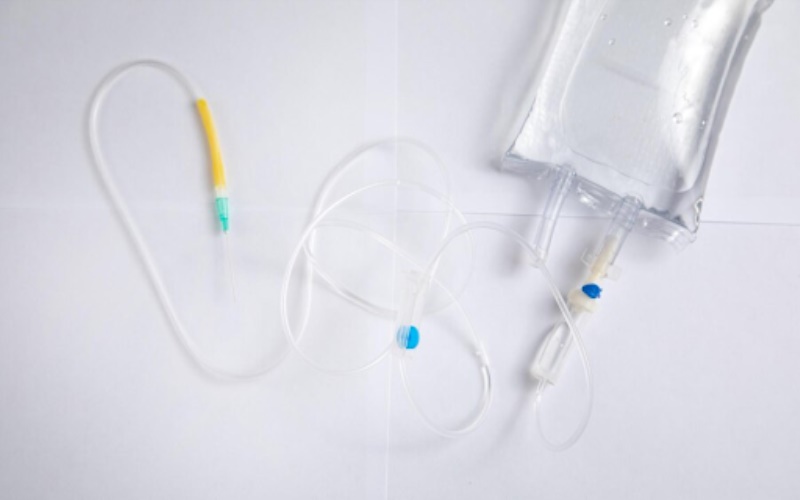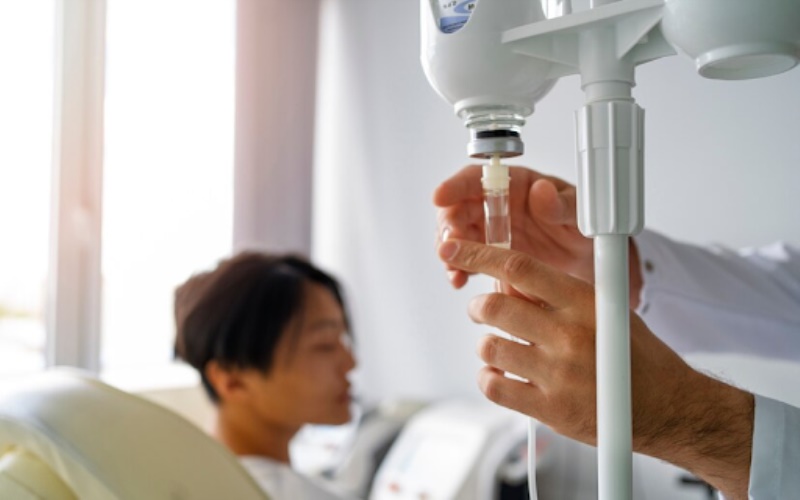Hydration is essential for maintaining overall health. It supports vital functions, impacting digestion, nutrient absorption, and detoxification. Adequate hydration improves cognition and mood, regulates body temperature, lubricates joints, and helps prevent diseases such as kidney stones or urinary tract infections. Therefore, staying hydrated should not be neglected.
An intravenous (IV) drip is a medical tool used to deliver nutrients, medication, and other substances directly into the body’s veins. It uses gravity to ensure a steady flow of liquid solutions via a small tube inserted in a patient’s arm or hand. The IV drip Bangkok enables quicker absorption as it bypasses the digestive system, leading to faster recovery and treatment for patients. This process is fundamental in various healthcare procedures, including surgery, chemotherapy for cancer patients, and emergency cases where rapid administration of medication is needed.
Linking IV drip therapy to quick and effective hydration.
IV drip therapy is a highly efficient method to hydrate the body rapidly. Directly infusing fluids into the bloodstream ensures faster absorption, promoting quick and effective hydration. Its use helps alleviate dehydration symptoms in medical and wellness contexts, proving its indispensability in health regimes.
Understanding IV Drip Therapy
Detailed explanation of IV drip therapy.
IV drip therapy involves administering medications or nutrients directly into the bloodstream using a small tube. It ensures rapid absorption and effect compared to oral ingestion, optimising therapeutic outcomes. Typical uses include dehydration treatment, nutrient supplementation, medication delivery, and supporting immune function in depleted individuals.
The technology behind IV drips.
IV drip technology involves gravity-fed bags holding fluids, tubes guided into a patient’s vein, and a control mechanism to regulate flow. The high-tech aspect includes electronic pumps for precise fluid delivery rates and smart IVs that alert healthcare professionals about potential errors or complications.
Benefits of IV Drip Therapy for Hydration
IV drip therapy for hydration rapidly replenishes the body with essential fluids and electrolytes. This method offers immediate absorption, bypassing the digestive system. It alleviates dehydration impacts like lethargy and cognitive issues. Ideal for athletes or those battling illness, this treatment promises efficient rehydration and revitalization.
A detailed description of how IV drip therapy aids in quick and effective hydration.
IV drip therapy delivers fluids directly into the bloodstream, ensuring rapid and effective hydration. The process bypasses the digestive system, allowing for 100% absorption. Essential elements like electrolytes, vitamins, and minerals are replenished instantly, easing dehydration symptoms effectively in contrast to oral intake.
An explanation of the benefits of getting hydrated through IV drip therapy over traditional methods.
IV drip therapy ensures efficient hydration, delivering fluids directly into the bloodstream for immediate absorption. It allows faster recovery from dehydration than traditional methods. The controlled delivery also enables precise nutrient supplementation, boosting immunity and wellness by circumventing any potential digestive complications.
Case studies showcasing the effectiveness of IV drip therapy.
Case studies demonstrate IV drip therapy’s effectiveness in enhancing hydration, boosting immunity, and improving wellness. They highlight patient recoveries from dehydration, chronic conditions, or nutrient deficiencies faster than traditional oral ingestion methods. Thus, IV drip therapy has notably revolutionised medical care delivery systems.

The Application of IV Drip Therapy
Identifying suitable scenarios for using IV drip therapy for hydration.
IV drip therapy for hydration is most suitable in scenarios requiring quick fluid replacement, such as dehydration, hangovers, athletic overexertion, or illnesses causing nausea and vomiting. It can also assist those with malabsorption conditions who struggle to retain essential vitamins and nutrients through oral intake.
Understanding the process of IV drip therapy.
IV drip therapy involves administering medication or fluids directly into a patient’s vein. It is an effective method for ensuring quick and efficient delivery of treatments. Such a procedure requires professional administration and training to monitor dosage, infusion speed, and possible reactions the patient might experience afterwards.
An overview of who should consider IV drip therapy.
IV drip therapy should be considered by individuals seeking to boost their overall health. Ideal candidates include people with chronic conditions, nutrient deficiencies, or those undergoing recovery from surgery. It’s equally beneficial for athletes needing quick rejuvenation and individuals battling hangovers or jet lags.
Risks and Considerations with IV Drip Therapy
Explanation of potential risks of IV drip therapy.
IV drip therapy carries potential risks such as infection at the insertion site, infiltration leading to tissue damage, air embolism (air entering the venous system), electrolyte imbalance, and overwhelming the circulatory system by administering fluids too quickly. Precautionary measures are vital to avoid these issues.
Information on who should avoid IV drip therapy.
Individuals with certain health conditions should avoid IV drip therapy. These include people with kidney disease, heart conditions, and those suffering from congestive heart failure. Pregnant women are also advised against it unless administered under strict medical supervision to prevent complications.
Guidance on the necessary professional consultation before opting for IV drip therapy.
Before initiating IV drip therapy, professional consultation is imperative. Medical practitioners can assess your overall health status and identify potential risks or contraindications. They provide personalised treatment plans, including the appropriate type and frequency of IV infusion to ensure safety and efficacy for optimal results.
The Future of Hydration: IV Drip Therapy
Understanding the advancements in IV drip technology.
Understanding advancements in intravenous drip technology has become crucial. Continuous improvements are aimed at increasing precision, especially with programmable pumps that compute exact flow rates. This technology delivers medication with profound accuracy and ensures the safety of patients, thus reducing medical mistakes integral to healthcare improvement worldwide.
Insight on how IV drip therapy is being adapted for various usages.
IV drip therapy, traditionally utilised for hydrating patients or administering medication, is becoming increasingly diversified. Its adaptability extends to the wellness and beauty industries, providing tailored treatments such as “cocktails” of vitamins or antioxidants directly into the bloodstream for optimum absorption and effectiveness.
A peek into the future: how IV drip therapy could revolutionise hydration in the future.
IV drip therapy could potentially revolutionise future hydration practices. Helping to combat dehydration, replenish nutrients, and clear toxins easily. Thus enabling a precise balance of fluids and electrolytes in the body. Providing a quick, efficient solution for athletic recovery and health management reliably.
IV drip FAQs
Are IV health drips good for you?
IV health drips can be beneficial in certain medical situations, delivering necessary fluids or medication swiftly to the body. However, for preventative health or wellness purposes, they may not always be advisable due to potential risks like infections and imbalanced nutrient levels.
Is an IV drip better than drinking water?
IV drips can provide hydration more effectively than drinking water, as they directly infuse fluids into the bloodstream. However, for most healthy individuals, regular fluid intake is adequate, and IV therapy should be reserved for medical situations under professional supervision due to potential risks.
Why are IV drips banned?
IV drips are banned primarily due to potential harm. They can lead to complications such as bloodstream infection, collapsed veins, and air embolism. Additionally, improper dosage may result in a toxic excess of certain substances, like vitamins or minerals, in the body.
Can IV drip cause side effects?
IV drips can indeed cause side effects, though they are rare. Unwanted repercussions may include blood clotting, infection at the injection site, possible air embolism, or allergic reactions to the medication being administered. Always monitor closely when receiving intravenous treatment.

